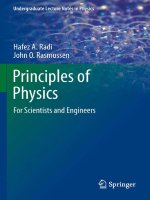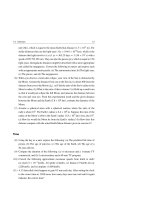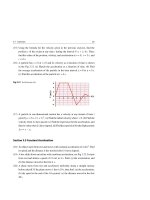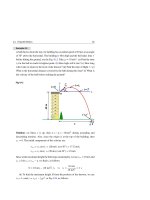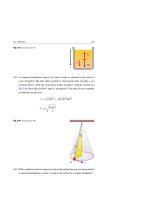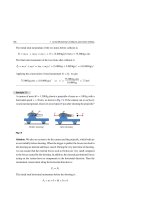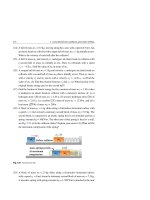Hafez a radi, john o rasmussen auth principles of physics for scientists and engineers 18
Bạn đang xem bản rút gọn của tài liệu. Xem và tải ngay bản đầy đủ của tài liệu tại đây (479.35 KB, 20 trang )
418
12 Heat and the First Law of Thermodynamics
Ti
cx , m x
Tx
Calorimeter
cc , m c
Aluminum
+
Initial
Ti
cw , m w
Initial
=
Tf
Tf
Tf
Water
Final
Fig. 12.26 See Exercise (12)
Subsection 12.1.3 Latent Heat
(13) Aluminum has a melting temperature of 660 ◦ C, latent heat of fusion of
3.97 × 105 J/kg, and specific heat of 900 J/kg.C◦ . How much heat is needed to
melt 15 kg of aluminum that is initially at 27 ◦ C?
(14) A runner loses 150 kcal of heat in 15 min by evaporating water from his skin.
The latent heat of vaporization of water at room temperature is 2.26 × 106 J/kg.
How much water has been lost?
(15) Follow similar steps like the calculations done in Fig. 12.4 to find the energy
required to change a 50 g ice cube from the ice state at −10 ◦ C to the steam
state at 110 ◦ C.
(16) A 150 g of ice is enclosed in a thermally insulated container. What is the mass
of steam at 100 ◦ C that must be mixed with the ice to produce liquid water at
50 ◦ C. (For the ice and steam, use the constants of Tables 12.1 and 12.2)
(17) A 100 g block of ice at 0 ◦ C is added to 400 g of water at 30 ◦ C. Assuming we
have a perfectly insulated calorimeter for this mixture, what will be its final
temperature when all of the ice has melted?
(18) A copper calorimeter has a mass mc = 100 g. The calorimeter contains water
of mass mw = 500 g at a temperature of 20 ◦ C. How much steam must be condensed into water if the final temperature of the mixture is to reach 50 ◦ C?
Assume the specific heat of copper is cc = 840 J/kg.C◦ , the specific heat of
water is cw = 4,186 J/kg.C◦ , and the latent heat of condensation of steam is
LV = 2.26 × 106 J/kg.
(19) A 60 kg ice skater glides from a speed vi = 10 m/s to a speed vf = 4 m/s on ice
at 0 ◦ C, see Fig. 12.27. Assume that 80% of the heat generated by friction is
12.6 Exercises
419
absorbed by the ice and all of the melted ice stays at 0 ◦ C. The latent heat of
fusion of ice is 3.33 × 105 J/kg. How much ice melts?
Fig. 12.27 See Exercise (19)
f
i
f
f
Section 12.2 Heat and Work (Take 1 atm
105 Pa)
(20) An ideal gas is enclosed in a container at a pressure of 2 atm and has a volume
of 3 m3 . What is the work done by the gas if: (a) the gas expands at a constant
pressure to three times its initial volume? (b) the gas is compressed at a constant
pressure to one half of its initial volume?
(21) (a) An ideal gas is taken from an initial state i to a final state f, as shown in
Fig. 12.28. Find the work done by the gas along the three paths iaf, if, and ibf.
(b) Answer part (a) if the gas is taken from f to i.
Fig. 12.28 See Exercise (21)
P (atm)
i
a
b
f
2
1
0
1
2
3
V (Liters)
Section 12.4 Applications of the First Law of Thermodynamics
(22) An ideal gas of 2 kmol is carried around the thermodynamic cycle as shown
in Fig. 12.29. The cycle consists of three parts; the isothermal expansion ab
at T = 300 K an isobaric compression bc, and an isovolumetric increase in
pressure ca. (a) When Pa = 4 atm and Pb = 1 atm, then find the work done by
the gas per cycle. (b) Answer part (a) when the direction of the cycle is reversed.
420
12 Heat and the First Law of Thermodynamics
Fig. 12.29 See Exercise (22)
P
a
Pa
Pb
Isotherm
T = 300 K
b
c
Va
Vb
V
(23) An ideal gas expands from an initial volume Va = 0.5 m3 to a final volume
Vb = 1.5 m3 in a quasi-static process for which P = kV, where k = 2.5 atm/m3 ,
see Fig. 12.30. How much work was done by the expanding gas?
Fig. 12.30 See Exercise (23)
P
b
kV
P=
a
Va
Vb
V
(24) An amount of work of 100 J is done on a system, and 100 cal of heat are
extracted from it. In light of the first law of thermodynamics, what are the
values (including algebraic signs) of: (a) W, (b) Q, and (c) Eint ?
(25) A cylindrical steel rod of mass 3.9 kg is heated from T = 27 ◦ C to T + T =
37 ◦ C at a constant atmospheric pressure, see Fig. 12.31. The rod has a density ρ
of 7.8 × 103 kg/m3 , a coefficient of volume expansion β of 3.3 × 10−6 (C◦ )−1 ,
and a specific heat c of 450 J/kg.C◦ . (a) How much work is done by the rod?
(b) How much heat is transferred to the rod? (c) What is the change in the rod’s
internal energy?
Fig. 12.31 See Exercise (25)
V
V+ΔV
T
T+ΔT
12.6 Exercises
421
(26) An ideal helium gas of 1 kmol is carried around the thermodynamic cycle as
shown in Fig. 12.32. The path ab is isothermal, with Pa = 2 atm, Pb = 1 atm,
and Va = 22.4 m3 . (a) What are the values of Ta , Vb , and Tc ? (b) How much
work is done by the gas in this cycle?
Fig. 12.32 See Exercise (26)
P
a
Pa
Isotherm
Pb
b
c
Va
Vb
V
(27) An ideal gas of one kmol does 4,000 J of work as it expands isothermally to
a volume of 12 × 10−3 m3 that has a final pressure of 2 atm. (a) What is the
temperature of the gas? (b) What is the initial volume of the gas?
(28) A fluid is carried through the cycle abcd as shown in Fig. 12.33. How much
work (in kilojoules) is done by the fluid during: (a) the isobaric expansion ab,
(b) the isovolumetric process bc, and (c) the isobaric compression cd? (d) What
is the net amount of heat transferred to work during the cycle abcd?
Fig. 12.33 See Exercise (28)
P (atm)
a
8
4
b
c
d
0
1
5
V (m3)
(29) At a constant pressure of 2 atm (2 Pa ), the boiling point of water is 120 ◦ C,
and its heat of vaporization is LV = 2.20 × 106 J/kg. Under these conditions,
assume a movable piston encloses 1 kg of water with a volume of Vi = 10−3 m3 ,
see the left part of Fig. 12.34. Heat is added from a reservoir until the liquid
water changes completely into steam of volume Vf = 0.824 m3 , see the right
part of Fig. 12.34. (a) How much work is done by the system (water + steam)
422
12 Heat and the First Law of Thermodynamics
during the boiling process? (b) How much heat energy is added to the system?
Freely moving piston
(c) What is the change in the internal energy of the system?
Insulation
2Pa
2Pa
Heat reservoir, 120 oC
Initial
2Pa
2Pa
2Pa
Vi
2Pa
Steam
Water
Vf
Q
Heat reservoir, 120 oC
Heat reservoir, 120 oC
Intermediate
Final
Fig. 12.34 See Exercise (29)
(30) An ideal gas has an initial temperature of 27 ◦ C and an initial volume of 1 m3 .
An isobaric expansion of the gas to a new volume of 3 m3 is achieved by adding
9,500 J of heat at a constant pressure of 3,000 Pa. (a) Determine the work done
by the gas during expansion. (b) What is the change in the internal energy of
the gas? (c) Find the final temperature of the gas.
(31) An ideal gas is taken from a to c along the curved path in Fig. 12.35. Along this
path, the work done by the gas is Wac = 15 J and the heat added to the gas is
Qac = 43 J. In addition, the work done along path abc is Wabc = 34 J. (a) What
is the change in internal energy of the gas Eac for path ac? (b) What is Qabc
for path abc? (c) What is Wcda for path cda? (d) What is Qcda for path cda?
Fig. 12.35 See Exercise (31)
P (atm)
2
1
d
c
a
b
V
0
Va
Vb
(32) Helium with an initial volume of 10−3 m3 and an initial pressure of 10 atm
expands to a final volume of 1 m3 . The relationship between pressure and
12.6 Exercises
423
volume during this expansion process is kept PV = constant by supplying heat
at a constant temperature. (a) Calculate the value of the constant. (b) Find the
final pressure. (c) Determine the work done by the helium during the expansion.
(d) How much heat was absorbed by the expanding helium?
Section 12.5 Heat Transfer
(33) The thermal conductivity of a special type of Pyrex glass at 0 ◦ C is
3 × 10−3 cal/cm.C◦ .s. (a) Express this quantity in W/m.C◦ and in Btu/ft.F◦ .h.
(b) What is the R value of a 1 cm sheet of Pyrex?
(34) A slab of a thermal insulator has a cross section of 0.1 m2 , a thickness of 2 cm,
and thermal conductivity of 0.1 J/m.s.C◦ . If the temperature difference between
the opposite faces of the insulator is 100 C◦ , how much heat flows through the
slab in 24 h?
(35) Consider the slab of copper shown in Fig. 12.36, where A = 9 × 10−3 m2 ,
L = 0.25 m, and the thermal conductivity is 400 W/m.C◦ . In the steady-state
condition, the temperature of the hot surface is TH = 125 ◦ C, and the temperature for the cold surface is TC = 10 ◦ C. Find the rate of heat transfer through
the slab.
Fig. 12.36 See Exercise (35)
Copper
TH > TC
A
Heat
flow
TH
TC
L
(36) A pair of metal plates having equal areas and equal thicknesses is in thermal
contact, as shown in Fig. 12.37. One plate is made of aluminum, and the other is
made of iron. Assume that the thermal conductivity of aluminum kA is exactly
three times that of iron kF . The outer face of the iron plate is maintained at
TC = 0 ◦ C, while the outer face of the aluminum plate is maintained at
TH = 60 ◦ C. In a steady-state condition, find the interface temperature T and
the relation that gives the rate of heat transfer by conduction through the slabs.
424
12 Heat and the First Law of Thermodynamics
Fig. 12.37 See Exercise (36)
Al
Fe
Heat flow
TH
TC
T
(37) Bricks and insulation are used to construct the walls of a house. The
insulation has R1 -value of 0.095 m2 .C◦ /W. The bricks have an R2 -value of
0.704 m2 .C◦ /W, see Fig. 12.38. In the steady-state condition, the temperature
inside the house is TH = 24 ◦ C and the outside temperature is TC = 10 ◦ C. Find
the rate of heat loss through such a wall, if its area is 20 m2 .
R2
TC
R1
Heat flow
TH
TH > TC
Fig. 12.38 See Exercise (37)
(38) A pipe made of steel has inner and outer radii of 2.5 and 3 cm respectively. The pipe carries hot water at a temperature TH = 70 C◦ and has a
thermal conductivity of 14 W/m.C◦ . The pipe’s outer surface temperature is
TC = 60 ◦ C, see the left part of Fig. 12.39. (a) What is the rate of heat flow per
unit length of the pipe? (b) When an additional cylindrical insulator of thermal
conductivity of 0.2 W/m.C◦ is used, see the right part of Fig. 12.39, what is the
thickness required to reduce heat loss by a factor of 10 and achieve an outer
temperature of 30 ◦ C?
(39) Show that the rate of heat that flows radially outwards in a spherically symmetric
system is governed by the equation:
12.6 Exercises
425
H = − 4π r 2 k
dT
dr
where r is the distance from the center of the source to the point where the temperature is T. When the inner and outer radii and temperatures are r H , rC , TH ,
and TC , respectively, show that:
H=
4π k(TH − TC )
(1/r H − 1/rC )
Fig. 12.39 See Exercise (38)
rC
TH
TH
rC
rH
rH
TC
TC
(40) An insulating spherical container has a total inner surface area of 1.5 m2 and
a thickness of 5 cm. A 60 W (assumed to be a point source) electric bulb
inside the container is used to maintain a constant temperature difference
TH − TC = 100 C◦ between the inside and the outside of the container, see
Fig. 12.40. What is the thermal conductivity k of the insulating material?
Fig. 12.40 See Exercise (40)
Insulator
Heat flow
TC
TH
TH > TC
Kinetic Theory of Gases
13
In the simplest model of an ideal gas, which was presented in Chap. 11, we
consider each atom/molecule to be a hard sphere that collides elastically with other
atoms/molecules or with the walls of the container holding the gas.
In this chapter, our aim is to relate macroscopic parameters (such as volume,
pressure, temperature, . . . etc.) to microscopic parameters (such as average kinetic
energy per molecule, internal energy of the gas, . . . etc.). To keep the mathematics
relatively simple, we develop a microscopic model that incorporates further justified
assumptions.
13.1
Microscopic Model of an Ideal Gas
In this model, the pressure P that a gas exerts on the walls of its encompassing
container, of volume V, is due to the collisions of n moles of the gas (or N = nNA
molecules) with those walls. Moreover, in such a model we assume that gases have
the following:
1. A large number of molecules
2. Large separations between molecules compared to their average sizes
3. Molecules that move randomly and obey Newton’s laws of motion
4. Negligible molecular collisions and experience only elastic collisions with the
walls of the container
5. A thermal equilibrium at temperature T with the container’s walls.
Now consider the collision of the ith molecule of such a gas with the colored yz
wall of a cubical container of side L, as shown in Fig. 13.1. In this figure, the gas
H. A. Radi and J. O. Rasmussen, Principles of Physics,
Undergraduate Lecture Notes in Physics, DOI: 10.1007/978-3-642-23026-4_13,
© Springer-Verlag Berlin Heidelberg 2013
427
428
13 Kinetic Theory of Gases
molecule of mass m is moving with velocity v→i which has the velocity components
vxi , vyi , and vzi .
Fig. 13.1 A cubical container
y
of side L, containing n moles
or N molecules of an ideal gas.
The figure shows an ith
molecule of mass m and
velocity →
v i that is about to
collide with the colored right
i
m
L
x
L
yz wall
z
L
Because we assume elastic collisions, only the x component of the above molecule’s velocity changes, while its y and z components remain unchanged. This is
illustrated in Fig. 13.2, which captures only the motion in the xy plane. Using the
definition of momentum (see Sect. 7.1), the only change in the molecule’s momentum is along the x-axis. Its momentum before the collision is mvxi and its momentum
after the collision is −mvxi . The change in momentum in one collision is:
⎫
pxi = (pxi )fin − (pxi )ini = −mvxi − mvxi = −2mvxi ⎪
⎪
⎬
pyi = 0
(13.1)
⎪
⎪
⎭
pzi = 0
Fig. 13.2 A molecule moving
in the xy plane undergoes an
y
yi
f
elastic collision with a wall
perpendicular to that plane.
xi
The x component of the
velocity is reversed, while the y
component remains unchanged
x
o
yi
θ
θ
i
xi
Since the momentum of the system (molecule + wall) is conserved, the momentum
delivered by the wall to the molecule for the ith molecule is
pxi = −2mvxi . The
13.1 Microscopic Model of an Ideal Gas
429
molecule in Fig. 13.1 will travel to the opposite wall and back again. It will repeat
this journey, hitting the colored wall repeatedly. The time between two successive
collisions with this wall is t. This means that the molecule travels with a speed vxi
a distance 2L in time
t. Thus:
t=
2L
vxi
(13.2)
This time is very small and the molecule will make many collisions with the wall,
each separated by time t. Therefore the number of collisions per unit time is large.
Consequently, the average force exerted on the ith molecule over many collisions
will be equal to the momentum change during one collision pxi divided by the time
t between collisions (Newton’s second law).
If Fxi is the average perpendicular force exerted by the wall on the molecule, then
from Newton’s third law, the average perpendicular force exerted on the wall by the
molecule is Fxi,on wall = −Fxi . That is:
Fxi,on wall = −Fxi = −
pxi
−2mvxi
2mvxi
=−
=
t
t
2L/vxi
(13.3)
2
mvxi
=
L
To find the total average force Fx,on wall exerted on the wall we must add up the
contributions of all molecules that strike the wall and then divide this total force by
the area of the wall. This gives the average pressure P on the wall. Thus:
2 /L + mv 2 /L + · · · + mv 2 /L
mvx1
Fxi,on wall
x2
xN
=
L2
L2
m 2
2
2
= 3 (vx1
+ vx2
+ · · · + vxN
)
L
P=
=
m
L3
(13.4)
N
2
vxi
i=1
Since the average value of the square of the x component of all the molecular speeds
is given by:
2 + v2 + · · · + v2
vx1
x2
xN
N
N
v2
= i=1 xi
N
vx2 =
(13.5)
and the volume of the container is given by V = L 3 , then we can express the average
pressure in the following form:
430
13 Kinetic Theory of Gases
P=
mN 2
v
V x
(13.6)
2 + v 2 + v 2 for the ith molecule, then this result and Eq. 13.5 lead
Since vi2 = vxi
yi
zi
to v 2 = vx2 + vy2 + vz2 . In addition, because there is a large number of molecules
moving randomly in all directions, the average values of the squares of their velocity
components are equal, i.e. vx2 = vy2 = vz2 .
Thus:
vx2 = vy2 = vz2 = 13 v 2
(13.7)
Hence, Eq. 13.6 can be expressed as:
P=
2
3
N
V
1
2
2 mv
(13.8)
The square root of v 2 is called the root mean square (rms) speed of the molecules
2 = v 2 . Thus:
and is symbolically written as vrms , i.e. vrms
vrms =
v2
(13.9)
By substitution, Eq. 13.8 will take on the form:
P=
2
3
N
V
1
2
2 mvrms
(13.10)
2 is the average translational kinetic energy per molecule. Equation
where 21 mvrms
13.10 connects the macroscopic quantities P and V to the microscopic quantity rep-
resenting the average molecular speed vrms .
We should remember that we ignored inter-molecular collisions as we derived Eq.
13.10. Note that these collisions only affect the momenta of the molecules and have
no net effect on the walls, so including such collisions will yield the same equation.
This is consistent with the random motion assumption, which implies that the velocity
distribution of the molecules does not change with time despite the collision between
molecules. In addition, this equation is valid for any shaped container, although it
was derived assuming a cubical container.
To get some insight into the meaning of temperature, we first rewrite Eq. 13.10
in the following form:
PV = 23 N
1
2
2 mvrms
Then we compare this with the ideal gas law Eq. 11.10:
(13.11)
13.1 Microscopic Model of an Ideal Gas
431
PV = NkB T
(13.12)
where this equation is based on experimental facts concerning the macroscopic
behavior of the ideal gas. Equating the right-hand sides of the last two equations, we
find that:
T=
2
3 kB
1
2
2 mvrms
(13.13)
2 is the average translational kinetic energy per molecule, we see
Since K = 21 mvrms
that temperature is a direct measure of it. In addition, we can relate the average
translational molecular kinetic energy per molecule to the temperature as follows:
2 = 3k T
K = 21 mvrms
2 B
(13.14)
2 , we can find the average translational kinetic
With vx2 = vy2 = vz2 = 13 v 2 = 13 vrms
energy per molecule associated with the motion along the x, y, and z axes as follows:
1
2
2 mvx
1
2
2 mvy
1
2
2 mvz
= 21 kB T
= 21 kB T
=
(13.15)
1
2 kB T
Thus, each translational degree of freedom1 contributes an equal amount of energy to
the gas, namely 21 kB T . A generalization of that is known as the theory of equipartition
of energy.
Theory of equipartition of energy:
The energy of a system experiencing thermal equilibrium is equally divided
among all degrees of freedom. Each degree of freedom contributes 21 kB T to
the energy of the system.
The total translational energy Ktot (which is the internal energy in this model) of
N molecules of an ideal gas is the product of N with the average translational energy
2 . That is:
per molecule K = 21 mvrms
1 The translational degrees of freedom refer to the number of independent ways by which a
molecule can possess energy when moving in a three-dimensional space.
432
13 Kinetic Theory of Gases
Ktot = N
1
2
2 mvrms
= 23 NkB T = 23 nRT
(13.16)
where we have used N = nNA for the number n of kilomoles of the gas and kB =
R/NA for Boltzmann’s constant.
Using the molar mass M = mNA in Eq. 13.16, where m here is the molecular
mass and not to be confused with the mass of the gas as in Chap. 11, we can relate
vrms to the gas temperature T as follows:
vrms =
3kB T
=
m
3RT
M
(13.17)
Table 13.1 shows some rms speeds calculated from Eq. 13.17.
Table 13.1 Some molecular speeds at room temperature (T = 300 K)
Gas
Molar mass (kg/kmol)
vrms (m/s)
Hydrogen (H2 )
2.02
1,925
Helium (He)
4.0
1,368
Water vapor (H2 O)
18
645
Nitrogen (N2 ) or Carbon monoxide (CO)
28
517
Nitrogen oxide (NO)
30
499
Oxygen (O2 )
32
484
Carbon dioxide (CO2 )
44
412
Sulfur dioxide (SO2 )
48
394
Example 13.1
Three moles of hydrogen gas are confined to a volume of 0.4 m3 at a temperature
of 24 ◦ C. (a) What is the total translational kinetic energy of the gas molecules?
(b) What is the average kinetic energy per molecule? (c) What is the rms speed
of the molecules?
Solution: (a) Using Eq. 13.16 with T = 24 + 273 = 297 K, we get:
Ktot = 23 nRT = 23 (3 × 10−3 kmol)(8.314 × 103 J/kmol.K)(297 K) = 1.1 × 104 J
(b) Using Eq. 13.14 with T = 297 K, we get:
K = 23 kB T =
3
2
(1.38 × 10−23 J/K)(297 K) = 6.15 × 10−21 J
(c) Using Eq. 13.17 with T = 297 K and the known hydrogen molar mass
M = 2.02 kg/kmol, we get
13.1 Microscopic Model of an Ideal Gas
vrms =
3RT
=
M
433
3(8.314 × 103 J/kmol.K)(297 K)
= 1,915 m/s
2.02 kg/kmol
Internal Energy of a Monatomic Ideal Gas
In the ideal-gas model presented in this section, we assumed each molecule behaved
like a hard sphere and had no structure. We were then able to find its average
translational kinetic energy in terms of the temperature of the gas. This average
kinetic energy is associated with the motion of the center of mass of each molecule.
This model does not include the energy associated with the internal motions of the
gas, such as the vibrational and rotational motions of the molecules.
In light of this, consider an ideal monatomic gas, such as helium (He), where
the gas molecules include only one atom. Essentially, all of the kinetic energy of
such monatomic molecules are associated with the motion of each molecule’s center
of mass. Therefore, when we add energy to a monatomic gas, all the added energy
goes into increasing the translational kinetic energy of the atoms. Thus, the total
internal energy Eint of an ideal monatomic gas of N atoms (or n kmol) at pressure
P, volume V, and temperature T will all be translational energy Ktot , i.e. Eint = Ktot .
Using Ktot = 23 NkB T = 23 nRT we find:
3
2 NkB T
3
2 nRT
Eint =
(Monatomic ideal gas)
or
Eint =
3
2 NkB
3
2 nR
(13.18)
T
T
In general, the internal energy of an ideal gas is a function of T only, and the exact
relationship depends on the type of gas.
Internal energy of an ideal gas:
The internal energy Eint of n kilomoles of an ideal gas is a function of the gas
temperature only; it does not depend on any other variable.
With this result, we are going to find two expressions for the molar specific heat
of an ideal gas. By convention, the symbol CV will be used when the gas volume is
434
13 Kinetic Theory of Gases
constant while heat energy is added, whereas the symbol CP will be used when the
gas pressure remains constant while heat energy is added.
13.2
Molar Specific Heat Capacity of an Ideal Gas
Consider an ideal gas undergoing several processes such that the change in temperature is achieved by taking a variety of different paths from one isotherm at temperature
T to another isotherm at temperature T + T , as shown in Fig. 13.3. Because T is
the same for each path, the change in internal energy Eint is the same for all paths.
However, from the first law of thermodynamics, Eint = Q − W, we know that the
heat Q is different for each path because W is different. Thus, the heat associated
with a given change in temperature
T does not have a unique value.
Fig. 13.3 An ideal gas is
P
Isotherms
taken from initial state i of
isotherm at temperature T to
P+ΔP
another at temperature
T+
fV
f
T along three different
P
paths. The change in internal
fP
i
energy is the same for all paths
T+ΔT
T
V
V+ΔV
V
We can treat this situation by defining specific heats for two processes that frequently occur: changes at constant volume and changes at constant pressure. Because
the number of moles is a convenient measure of the amount of gas, we define the
molar specific heats associated with these processes with the following equations:
QV = nCV T
(Constant volume)
(13.19)
QP = nCP T
(Constant pressure)
(13.20)
where n now is the number of moles, CV is the molar specific heat at constant
volume, and CP is the molar specific heat at constant pressure. When we deliver
heat to the gas at constant pressure, the heat QP must account for both the increase in
internal energy Eint and the work W. But, when we deliver heat to the gas at constant
volume, then the heat QV must account for only the same increase in internal energy
13.2 Molar Specific Heat Capacity of an Ideal Gas
435
Eint , since W = 0. For this reason, QP is greater than QV for all given values of n
and T . Thus, CP is greater than CV .
The molar specific heat capacities CV and CP are related to the specific heats cV
and cP by the following two relations:
CV = M cV
(13.21)
CP = M cP
where M is the molar mass of the gas.
13.2.1 Molar Specific Heat at Constant Volume
We consider n moles of an ideal gas at pressure P and temperature T, confined to a
cylinder of fixed volume V, as shown in Fig. 13.4a. The initial state i of the gas is
identified on the PV graph of Fig. 13.4b. When we add a small amount of heat QV to
the gas, by slowly turning up the temperature of a heat reservoir, the gas temperature
rises to T + T and its pressure rises to P + dP, bringing the gas to the final state f
that is identified in Fig. 13.4b.
Fixed volume process
Fixed
piston
P
QV
P+ΔP
f
P
i
QV
Isotherms
T+ΔT
Insulation
T
Heat reservoir
(a)
Temperature
Control nob
V
V
(b)
Fig. 13.4 (a) The temperature of an ideal gas is increased from T to T + T in a constant volume process
by adding heat QV . (b) The constant volume process i → f on a PV diagram
Since W = P dV = 0 for a constant volume process, then all of the transferred
energy will be stored in the gas as an increase in its internal energy, and the change
in the internal energy of the gas will be given by the first law of thermodynamics as:
Eint = QV
(13.22)
436
13 Kinetic Theory of Gases
Substituting this expression into Eq. 13.19, we get:
QV =
Eint = nCV T
(Ideal gas)
(13.23)
If the molar specific heat CV is constant, we can express the internal energy of an
ideal gas as:
Eint = nCV T
(Ideal gas)
(13.24)
This equation applies to all ideal gases (to gases having one or more than one atom
per molecule). In the limit of infinitesimal changes, we can use Eq. 13.24 to express
the molar specific heat at constant volume as follows:
CV =
1 dEint
n dT
(13.25)
For monatomic gases, if we substitute the internal energy Eint = 23 nRT from
Eq. 13.18 into Eq. 13.25, we get:
CV = 23 R =
12.5 J/mol.K
12.5 × 103 J/kmol.K
(Monatomic ideal gas)
(13.26)
This result is in agreement with experimentally measured values for monatomic gases
at a wide range of temperatures.
13.2.2 Molar Specific Heat at Constant Pressure
We now consider n moles of an ideal gas at pressure P and temperature T, confined
to a volume V by a freely moving piston, as shown in Fig. 13.5a. The initial state i
of the gas is identified on the PV diagram of Fig. 13.5b. Under a constant pressure,
a small amount of heat QP is added to the gas, by slowly turning up the temperature
of a heat reservoir; the gas temperature rises to T + T , bringing the gas to the final
state f that is identified in Fig. 13.5b.
To relate CP to CV , we start with the first law of thermodynamics:
Eint = QP − W
(13.27)
and then replace each term. From Eq. 13.23, we have:
Eint = nCV T
(13.28)
13.2 Molar Specific Heat Capacity of an Ideal Gas
437
Fixed pressure process
Freely
moving
piston
P
P
QP
Isotherms
P
f
P
QP
T+ΔT
i
Insulation
PΔV
Heat reservoir
Temperature
Control nob
(a)
T
V+ΔV
V
V
(b)
Fig. 13.5 (a) The temperature of an ideal gas is increased from T to T +
T in a constant pressure
process by adding heat QP . (b) The work P dV is given by the colored area for the constant pressure
process i → f on the PV diagram
Also, from Eq. 13.20, we have:
QP = nCP T
(13.29)
The work done by the ideal gas in the constant pressure process of Fig. 13.5b is
W = P V. Then we use the ideal-gas equation PV = nRT to find W as follows:
W = P V = nR T
(13.30)
Substituting with Eq. 13.28, 13.29, and 13.30 into Eq. 13.27, and then dividing by
n T , we find
CP − CV = R
(13.31)
This prediction of kinetic theory agrees well with experiments, not only for monatomic
gases but for gases in general, as long as their density is low enough so that we may
treat them as ideal.
For monatomic gases, we substitute with CV = 3R/2 into Eq. 13.31 to find:
CP = 25 R =
20.8 J/mol.K
20.8 × 103 J/kmol.K
(Monatomic ideal gas)
(13.32)
The ratio of the molar specific heats CP and CV is a dimensionless quantity γ given
by:
438
13 Kinetic Theory of Gases
γ =
CP
=
CV
5
2R
3
2R
=
5
= 1.67
3
(Monatomic ideal gas)
(13.33)
Theoretical values of CV , CP , and γ are in excellent agreement with experimental
values obtained for monatomic gases, but they are in serious disagreement with the
values for more complex gases (those with multiple atoms per molecule). This is
because their internal energy Eint , and their molar specific heats CP and CV include
components from rotational and vibrational motions of the molecules.
Example 13.2
A cylinder contains 2 moles of helium at a temperature of 27 ◦ C. Heat is added
to the gas to increase its temperature to 227 ◦ C. (a) Find the quantity of heat QV
used if the gas was heated at constant volume. (b) Find the quantity of heat QP
and the work done by the gas W if the gas was heated at constant pressure.
Solution: (a) Treating the helium gas as an ideal monatomic gas, the work done in
this case is zero. We use CV = 3R/2 = 12.5 J/mol.K and T = 227 ◦ C − 27 ◦ C =
200 C◦ = 200 K in Eq. 13.23 to get:
QV = nCV T = (2 mol)(12.5 J/mol.K)(200 K) = 5,000 J
(b) For a constant pressure process we use CP = 5R/2 = 20.8 J/mol.K in
Eq. 13.20 to get:
QP = nCP T = (2 mol)(20.8 J/mol.K)(200 K) = 8,320 J
The work done by the gas in this process is:
W = QP − QV = 8,320 J − 5,000 J = 3,320 J
Example 13.3
A cylinder contains 5 moles of monatomic helium. At constant pressure, the
helium gas undergoes a volume expansion and a temperature increase T =
Tf − Ti = 20 C◦ due to the addition of heat QP , as shown in Fig. 13.6. (a) How
much heat QP is added to the helium? (b) What is the change
Eint in the internal
energy of the helium? (c) How much work W is done by the helium as it expands?
